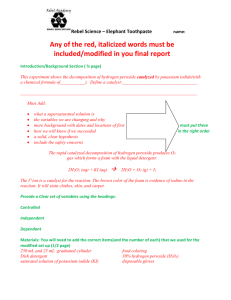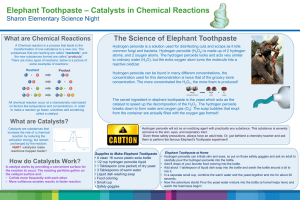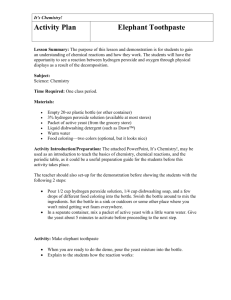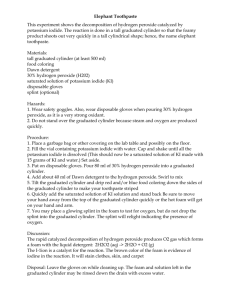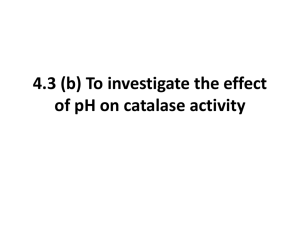Elephant Toothpaste
advertisement
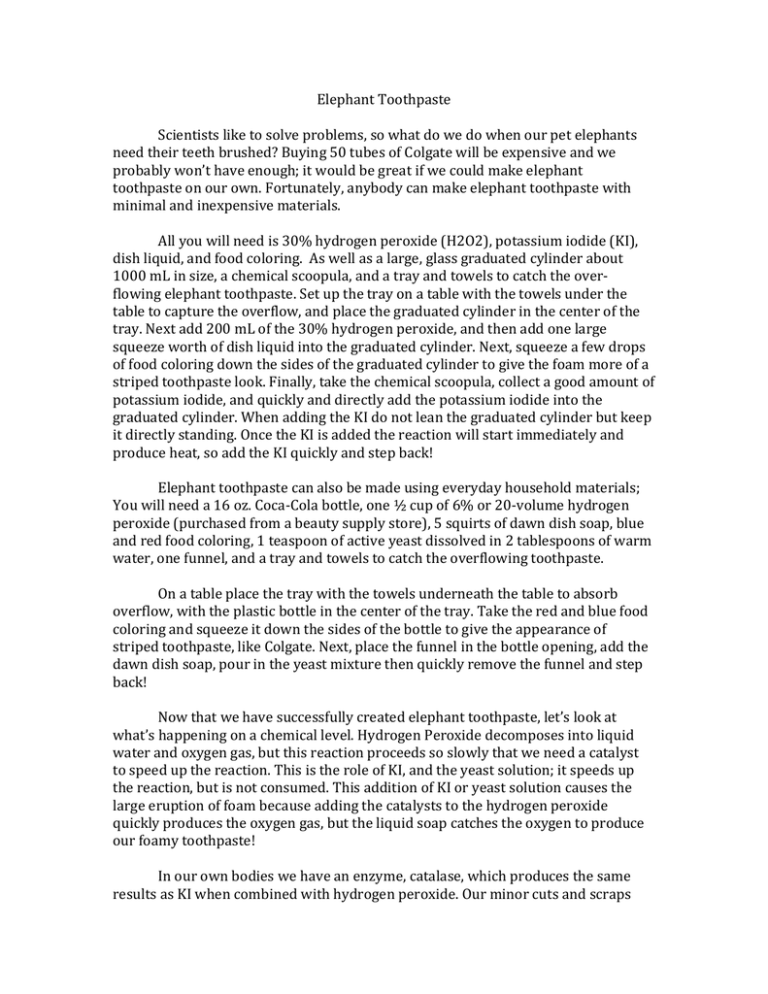
Elephant Toothpaste Scientists like to solve problems, so what do we do when our pet elephants need their teeth brushed? Buying 50 tubes of Colgate will be expensive and we probably won’t have enough; it would be great if we could make elephant toothpaste on our own. Fortunately, anybody can make elephant toothpaste with minimal and inexpensive materials. All you will need is 30% hydrogen peroxide (H2O2), potassium iodide (KI), dish liquid, and food coloring. As well as a large, glass graduated cylinder about 1000 mL in size, a chemical scoopula, and a tray and towels to catch the overflowing elephant toothpaste. Set up the tray on a table with the towels under the table to capture the overflow, and place the graduated cylinder in the center of the tray. Next add 200 mL of the 30% hydrogen peroxide, and then add one large squeeze worth of dish liquid into the graduated cylinder. Next, squeeze a few drops of food coloring down the sides of the graduated cylinder to give the foam more of a striped toothpaste look. Finally, take the chemical scoopula, collect a good amount of potassium iodide, and quickly and directly add the potassium iodide into the graduated cylinder. When adding the KI do not lean the graduated cylinder but keep it directly standing. Once the KI is added the reaction will start immediately and produce heat, so add the KI quickly and step back! Elephant toothpaste can also be made using everyday household materials; You will need a 16 oz. Coca-Cola bottle, one ½ cup of 6% or 20-volume hydrogen peroxide (purchased from a beauty supply store), 5 squirts of dawn dish soap, blue and red food coloring, 1 teaspoon of active yeast dissolved in 2 tablespoons of warm water, one funnel, and a tray and towels to catch the overflowing toothpaste. On a table place the tray with the towels underneath the table to absorb overflow, with the plastic bottle in the center of the tray. Take the red and blue food coloring and squeeze it down the sides of the bottle to give the appearance of striped toothpaste, like Colgate. Next, place the funnel in the bottle opening, add the dawn dish soap, pour in the yeast mixture then quickly remove the funnel and step back! Now that we have successfully created elephant toothpaste, let’s look at what’s happening on a chemical level. Hydrogen Peroxide decomposes into liquid water and oxygen gas, but this reaction proceeds so slowly that we need a catalyst to speed up the reaction. This is the role of KI, and the yeast solution; it speeds up the reaction, but is not consumed. This addition of KI or yeast solution causes the large eruption of foam because adding the catalysts to the hydrogen peroxide quickly produces the oxygen gas, but the liquid soap catches the oxygen to produce our foamy toothpaste! In our own bodies we have an enzyme, catalase, which produces the same results as KI when combined with hydrogen peroxide. Our minor cuts and scraps have catalase amidst the blood and skin cells, so when we add hydrogen peroxide the same bubbling effect is observed. The resulting high oxygen environment, from the rapid creation of oxygen gas, is a fatal environment for bacteria. This is why we use hydrogen peroxide for our minor cuts and scrapes. References: Steve Spangler Science. http://www.stevespanglerscience.com/experiment/elephants-toothpaste. About.com, Chemistry Education. http://chemistry.about.com/od/chemistrydemonstrations/a/elephanttooth.htm.

